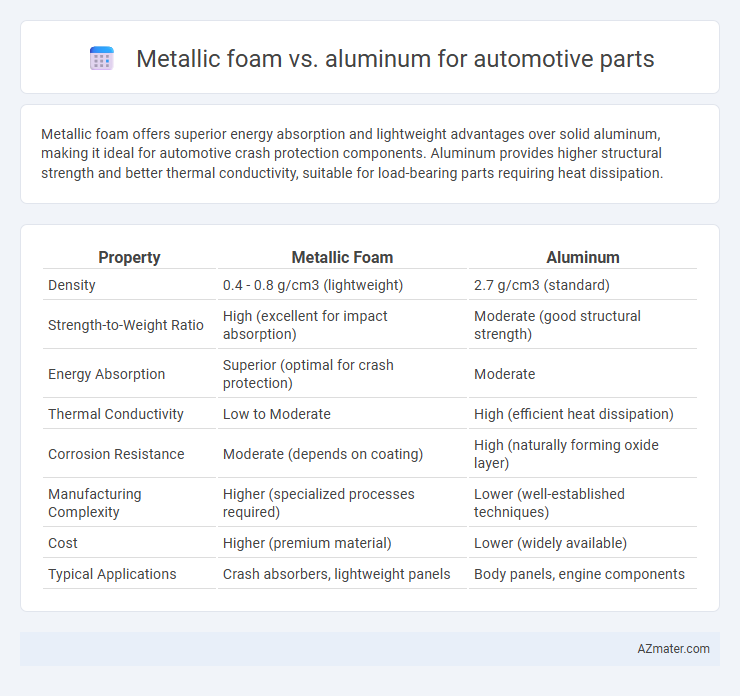Metallic foam offers superior energy absorption and lightweight advantages over solid aluminum, making it ideal for automotive crash protection components. Aluminum provides higher structural strength and better thermal conductivity, suitable for load-bearing parts requiring heat dissipation.
Table of Comparison
| Property | Metallic Foam | Aluminum |
|---|---|---|
| Density | 0.4 - 0.8 g/cm3 (lightweight) | 2.7 g/cm3 (standard) |
| Strength-to-Weight Ratio | High (excellent for impact absorption) | Moderate (good structural strength) |
| Energy Absorption | Superior (optimal for crash protection) | Moderate |
| Thermal Conductivity | Low to Moderate | High (efficient heat dissipation) |
| Corrosion Resistance | Moderate (depends on coating) | High (naturally forming oxide layer) |
| Manufacturing Complexity | Higher (specialized processes required) | Lower (well-established techniques) |
| Cost | Higher (premium material) | Lower (widely available) |
| Typical Applications | Crash absorbers, lightweight panels | Body panels, engine components |
Introduction to Metallic Foam and Aluminum in Automotive Applications
Metallic foam, characterized by its lightweight structure and high energy absorption, offers significant advantages in automotive applications where weight reduction and crash safety are critical. Aluminum, widely used in the automotive industry, provides excellent strength-to-weight ratio, corrosion resistance, and recyclability, making it a preferred material for structural components. Combining metallic foam with aluminum can enhance vehicle performance by improving stiffness, reducing weight, and increasing impact resistance in automotive parts.
Material Properties Comparison: Metallic Foam vs Aluminum
Metallic foam offers superior energy absorption and impact resistance compared to solid aluminum, making it ideal for automotive crash protection components. While aluminum provides excellent strength-to-weight ratio and corrosion resistance, metallic foam's porous structure significantly reduces density and enhances thermal insulation properties. The combination of lightweight and enhanced mechanical damping in metallic foam improves fuel efficiency and passenger safety over conventional aluminum parts.
Weight Reduction and Fuel Efficiency
Metallic foam offers significant weight reduction compared to traditional aluminum, with densities as low as 0.45 g/cm3 versus aluminum's typical 2.7 g/cm3, enhancing automotive fuel efficiency through reduced mass. Its porous structure provides high strength-to-weight ratios, enabling lightweight designs without compromising structural integrity. Implementing metallic foam in automotive components results in lower vehicle weight, directly decreasing fuel consumption and emissions.
Crashworthiness and Energy Absorption Capabilities
Metallic foam exhibits superior energy absorption capabilities compared to traditional aluminum due to its cellular structure, which effectively dissipates impact forces during a crash. Its high strength-to-weight ratio enhances automotive crashworthiness by reducing vehicle mass while maintaining structural integrity. Aluminum, while lightweight, typically offers less controlled deformation under impact, making metallic foam a preferred material for advanced energy-absorbing automotive components.
Thermal Conductivity: Performance in Automotive Environments
Metallic foam exhibits lower thermal conductivity compared to solid aluminum, making it less efficient for rapid heat dissipation in automotive parts exposed to high-temperature conditions. Aluminum's thermal conductivity ranges from 205 to 250 W/mK, providing superior heat transfer, which is crucial for engine components and heat exchangers. Despite metallic foam's reduced conductivity, its lightweight structure offers benefits in thermal insulation and noise reduction, balancing performance priorities in automotive design.
Corrosion Resistance and Durability
Metallic foam exhibits superior corrosion resistance compared to traditional aluminum due to its porous structure, which can be enhanced with protective coatings. The combination of lightweight characteristics and high energy absorption makes metallic foam highly durable under impact and fatigue conditions in automotive applications. Aluminum, while corrosion-resistant in many environments, may require additional treatments to achieve similar longevity and performance in harsh conditions.
Manufacturing Processes and Costs
Metallic foam offers lightweight properties and enhanced energy absorption but requires complex manufacturing processes such as powder metallurgy or investment casting, increasing production costs compared to traditional aluminum parts. Aluminum parts benefit from well-established manufacturing methods like extrusion, casting, and stamping, resulting in lower costs and faster production cycles. Despite higher initial expenses, metallic foam components provide superior crashworthiness and weight reduction, influencing cost-performance trade-offs in automotive applications.
Sustainability and Recycling Potential
Metallic foam offers superior sustainability for automotive parts due to its lightweight structure, reducing vehicle fuel consumption and emissions over the product lifecycle. Aluminum's high recyclability supports circular economy goals, with an established recycling infrastructure that conserves energy by up to 95% compared to primary production. Combining metallic foam with aluminum alloys enhances structural performance while maintaining recyclable integrity, optimizing both environmental impact and material efficiency in automotive manufacturing.
Case Studies: Successful Automotive Implementations
Metallic foam has been successfully implemented in automotive cases such as the BMW i3's crash management system, where its lightweight and energy absorption properties enhance safety and reduce vehicle weight. Aluminum remains a staple material in automotive parts like the Ford F-150's body panels, providing high strength-to-weight ratios and corrosion resistance critical for durability. Case studies highlight metallic foam's superior energy absorption in crash scenarios, while aluminum dominates in structural applications requiring balance between strength and weight.
Future Trends and Industry Perspectives
Metallic foam offers superior energy absorption and lightweight properties compared to traditional aluminum, making it a promising material for automotive safety components and structural parts. Advances in manufacturing techniques such as additive manufacturing and powder metallurgy are enabling more cost-effective and scalable production of metallic foam for mass-market vehicles. Industry perspectives emphasize the integration of metallic foam in electric and autonomous vehicles to enhance crashworthiness and reduce overall vehicle weight, aligning with future trends in sustainability and performance optimization.

Infographic: Metallic foam vs Aluminum for Automotive part
 azmater.com
azmater.com